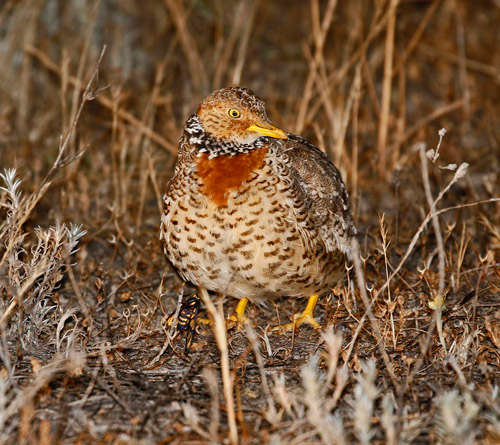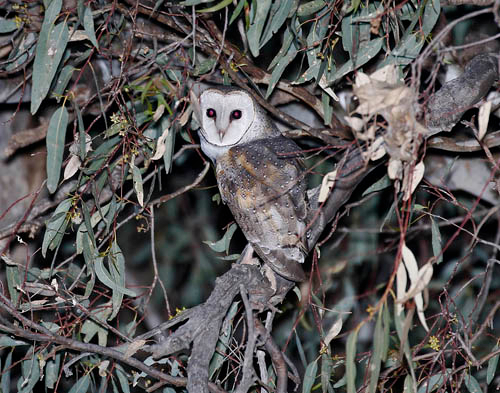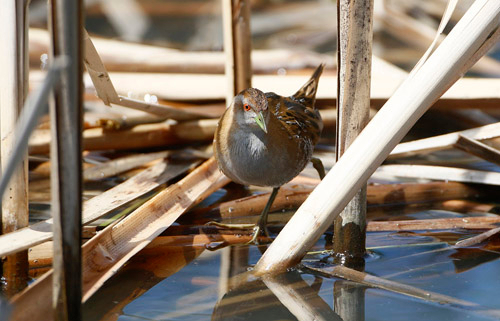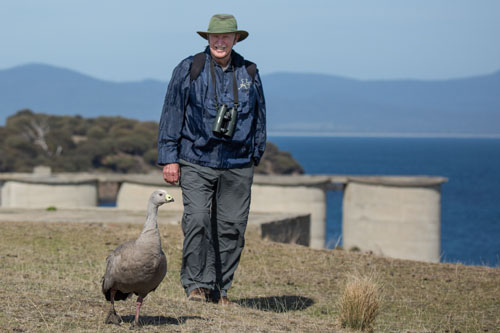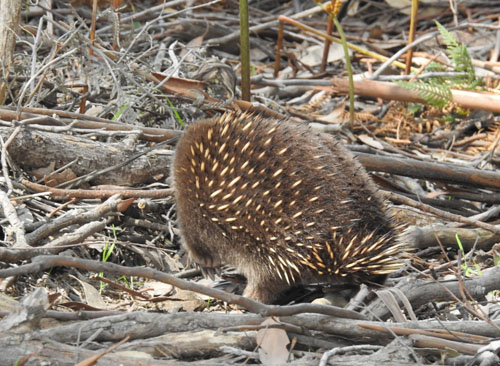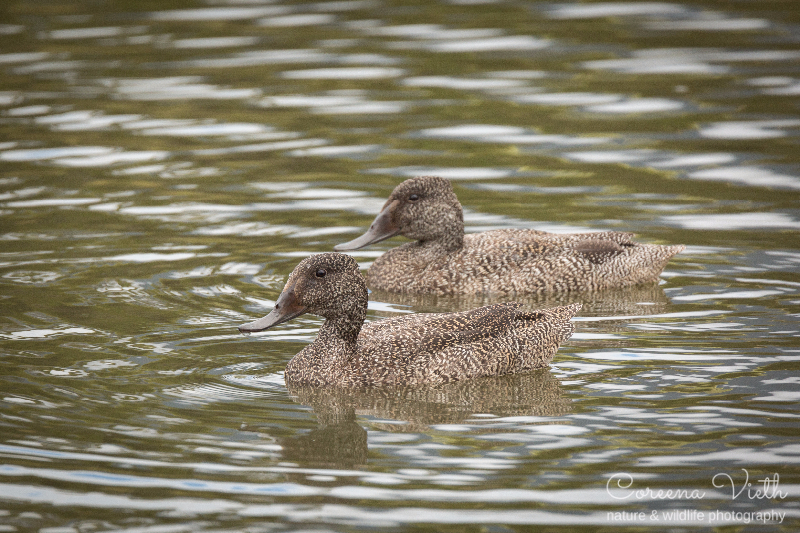On October 22 I boarded the 1:45 p.m. bus from Deniliquin to Melbourne’s Southern Cross Station, and then the Skybus to the airport, in time to board my 7:55 p.m. flight to Darwin. Arriving in Darwin after 10:00 p.m., the Darwin Airport Novotel Hotel turned out to be an easy, and short, walk from the airport. My scheduled 7:00 a.m. next morning start for a day of birding at Fogg Dam fell through due to the illness of the guide that Experience the Wild had assigned to me. I used the morning to bird in the park near the hotel. In the afternoon, my guide, Diana, was well enough to provide an interesting afternoon of birding in areas around Darwin.
During the morning I saw a few new birds, including several Torresian Imperial Pigeons and Red-collared Lorikeets. In the afternoon Diana drove us to a nearby mangrove park where we were able walk on a boardwalk to a bench in the mangroves where we sat quietly and observed several flycatchers, kingfishers and other small birds. We then drove to a park overlooking the water, where good sightings included a nesting Eastern Reef Heron with chick and several Beach Stone-curlews. We then drove out of the city to a location where Diana has had success in the past with Rainbow Pittas, but none was to be seen, the first miss for her in 18 trips. Sitting high in a large tree where we entered the park, were 2 Radjah Shelducks, completing my sweep of the Australian ducks. We were able to observe a few Magpie Geese, the seventh and final new family that I had been hoping to see, and did see, in Australia. Although called a goose, the Magpie Goose is not part of the large Anatadae family, but instead is the sole member of the Anseranatadae family. We saw a few Magpie Geese in Darwin, but in subsequent days they numbered in the 1000s in the Fogg Dam area and Kakadu National Park.
Diana was not well enough to conduct the rest of the Northern Territory tour to Kakadu. Experience the Wild owner, Mike Jarvis, arranged to have an independent guide, Luke Paterson, fill in for the next few days. Luke, along with 2 other birders, Graham and Susan Kearns from Canberra, picked me up at the hotel the next morning and we headed for Kakadu, some 100 miles or so to the east. But first, we stopped at Fogg Dam. One of the first birds to show was a colorful Rainbow Pitta, the one that Diana and I had searched for the day before with no success. Water birds present, some in large numbers, included Brolgas (storks) and many Magpie Geese. As we ate our “take-out” breakfast in a little pull-out near the dam, Rose-crowned Fruit Doves dined high in the trees above us. After venturing on foot out on the dam, always on the lookout for crocs, we drove on toward Kakadu.
Kakadu is a large national park. The land is owned by several aboriginal clans, or groups, and is jointly(?) managed with the government. It has been designated an important UNESCO World Heritage Area. It boasts woodlands, wetlands, plateaus, escarpments, waterfalls, rivers, aboriginal rock art sites, birds, mammals, crocodiles, and unique vegetation. Unfortunately, invasive species of animals and vegetation create serious problems for the native flora and fauna. Many feral (domestic animals gone wild) buffalo (not the bison kind), pigs, horses (brumbies), and donkeys, roam and damage the park. Invasive Cane Toads, toxic to much wild life, are present. Invasive grasses have spread and pose a problem for native vegetation and wildlife, including birds.
We stopped at the entrance to Kakadu for a picture of Graham and Susan Kearns and me.
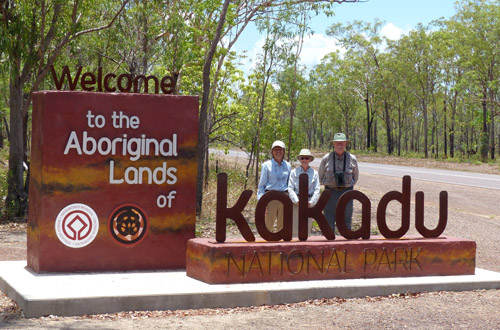
and Luke:

Toward evening we visited one of the rock art sites, an old occupational site called Burrungkuy (often misidentified as Nourlangie Rock). One of the more famous and interesting works is this aborigine depiction of the Creator in the dreamtime, (the larger figure), and his wife.

The rock art is definitely worth seeing. We hiked on up to a vantage point looking to the east toward the large territory within Northern Territory, called Arnhem Land, the name reflecting the influence of the Dutch historical explorations of the northern coast of Australia. This Arnhem Land Escarpment shone in the afternoon light.

Among the birds seen at Kakadu were:
Comb-crested Jacanas

Lemon-bellied Flycatcher

Forest Kingfisher

Pied Heron

Whistling Ducks and Magpie Geese

The next morning we arose very early (at Luke’s insistence) to claim the best birding seats on board a ~30 passenger sightseeing boat on a slow cruise of the Yellow Water.

This slow-paced cruise was perfect for viewing the life of the River, including this Nankeen Night Heron dangerously close to one of the many Salt Water Crocodiles.


A Buffalo bull was cooling himself at the edge of the river, serving as a perch for a Western Cattle Egret.
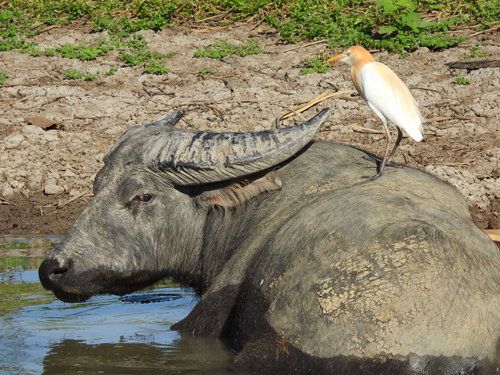
We were pleased to find two lovely Kingfishers, an Azure Kingfisher

and a Little Kingfisher

Other photographs by Luke include:
Great-billed Heron

Grey Goshawk

Pied Cormorant
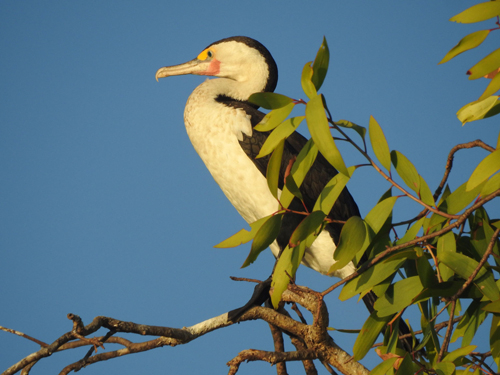
Plumed Whistling Duck

White-gaped Honeyeater

Susan is here pictured with one of the many Giant Termite Mounds scattered throughout the Park.

We drove south through the park to the little town of Pine Creek, where we would spend our last evening before returning to Darwin. As we drove into Pine Creek, several lovely Hooded Parrots were loitering near a water pipe.

At dinner in the local restaurant that night we met Mike Jarvis, the owner of Experience the Wild, who was dining there with clients. The next morning, Luke insisted (again) that we get a very early start to have the best shot of seeing one of Australia’s most colorful birds, Gouldian Finches, when they came to drink at a little hole in an otherwise dry river.


Also making its appearance near the water hole was a Crimson Finch.

Other birds seen as we wound our way back to Darwin were:
Pacific Baza

Pink-eared Ducks and friends

One of the more interesting features were these Magnetic Termite Mounds.

Magnetic termites are only found in the Darwin area of Northern Territory. The colony looks like a cemetery, with slab-shaped grave stones up to 10 feet high, all oriented with the narrow sides to the north and south. Hence, “magnetic”, I suppose, for orientation toward the magnetic north pole. It is said that this is to stabilize mound temperature by minimizing heat from the noon-day sun, while maximizing the heat from the cooler morning (east) and evening (west) rays.
I finished the Darwin, Northern Territory portion of my trip with 139 bird species seen, of which 62 were new life birds. Luke was an excellent guide and fun to be with. Graham and Susan were unexpected participants on the trip, and my thanks to them for making the time so enjoyable. Graham and Luke provided the photographs for this blog and allowed me to use them. Thanks to them both.
The next morning I will fly from Darwin to Alice Springs, about 1,000 kilometers south but still in Northern Territory, for my final 2 days of birding in Australia. Mark Carter, Alice Springs Birding Guide, is supposed to meet me at the airport when I arrive at 9:00 a.m., and he does so in spite of some last minute confusion regarding the time of my arrival. Birding around Alice Springs will be the subject of my 5th and final October, 2017 Australian birding blog. That will be a while in coming, though, because Mark’s computer was ruined by torrential rains (Yes, in Alice Springs), but he expects to recover the pictures and send them to me for inclusion in my Alice Springs blog, sometime in January, 2018.


